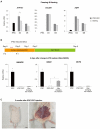Therapeutic Potency of Induced Pluripotent Stem-Cell-Derived Corneal Endothelial-like Cells for Corneal Endothelial Dysfunction
- PMID: 36614165
- PMCID: PMC9821383
- DOI: 10.3390/ijms24010701
Therapeutic Potency of Induced Pluripotent Stem-Cell-Derived Corneal Endothelial-like Cells for Corneal Endothelial Dysfunction
Abstract
Corneal endothelial cells (CECs) do not proliferate or recover after illness or injury, resulting in decreased cell density and loss of pump/barrier function. Considering the shortage of donor cornea, it is vital to establish robust methods to generate CECs from induced pluripotent stem cells (iPSCs). We investigated the efficacy and safety of transplantation of iPSC-derived CECs into a corneal endothelial dysfunction (CED) rabbit model. iPSCs were generated from human fibroblasts. We characterized iPSCs by demonstrating the gene expression of the PSC markers OCT4, SOX2, TRA-1-60, and NANOG, teratoma formation, and differentiation into three germ layers. Differentiation of iPSCs into CECs was induced via neural crest cell (NCC) induction. CEC markers were detected using immunofluorescence and gene expression was analyzed using quantitative real-time PCR (qRT-PCR). After culturing iPSC-derived NCCs, we found the expression of zona occludens-1 (ZO-1) and Na+/K+ ATPase and a hexagonal morphology. ATP1A1, COL8A1, and AQP1 mRNA expression was higher in iPSC-derived CECs than in iPSCs and NCCs. We performed an injection of iPSC-derived CECs into the anterior chamber of a CED rabbit model and found improved levels of corneal transparency. We also found increased numbers of ZO-1- and ATP1A1-positive cells in rabbit corneas in the iPSC-derived CEC transplantation group. Usage of the coating material vitronectin (VTN) and fasudil resulted in good levels of CEC marker expression, demonstrated with Western blotting and immunocytochemistry. Combination of the VTN coating material and fasudil, instead of FNC mixture and Y27632, afforded the best results in terms of CEC differentiation's in vitro and in vivo efficacy. Successful transplantation of CEC-like cells into a CED animal model confirms the therapeutic efficacy of these cells, demonstrated by the restoration of corneal clarity. Our results suggest that iPSC-derived CECs can be a promising cellular resource for the treatment of CED.
Keywords: cell injection; cell therapy; corneal endothelial cells; corneal endothelial dysfunction; induced pluripotent stem cell.
Conflict of interest statement
The authors declare no conflict of interest. The funders had no role in the design of the study; in the collection, analysis, or interpretation of data; in the writing of the manuscript; or in the decision to publish the results.
Figures







References
-
- Hatou S., Higa K., Inagaki E., Yoshida S., Kimura E., Hayashi R., Tsujikawa M., Tsubota K., Nishida K., Shimmura S. Validation of Na,K-ATPase pump function of corneal endothelial cells for corneal regenerative medicine. Tissue Eng. Part C Methods. 2013;19:901–910. doi: 10.1089/ten.tec.2013.0030. - DOI - PubMed
-
- Bourne W.M., Nelson L.R., Hodge D.O. Central corneal endothelial cell changes over a ten-year period. Investig. Ophthalmol. Vis. Sci. 1997;38:779–782. - PubMed
MeSH terms
Substances
Grants and funding
LinkOut - more resources
Full Text Sources
Other Literature Sources
Research Materials
Miscellaneous

